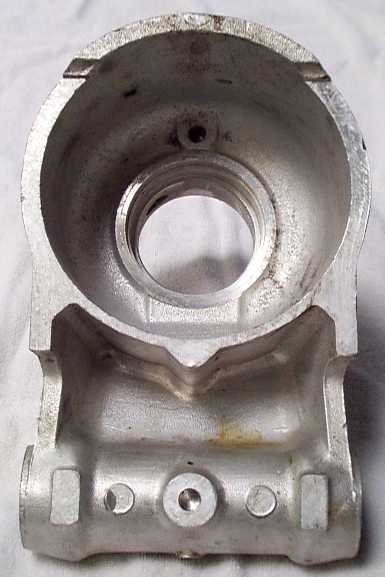| |||||||||||
| |||||||||||
IRS Hub Carrier Cracks
That's the crack, just below the yellow paint spot. HubCarrierCrackCU.jpg is a close-up of the cracked area. Here's the differential side of the same part:  It's hard to see, but the cracks appear in essentially the same place as on the wheel side -- indicating that the crack is not superficial, but actually goes clear through the part. HubCarrierCrackBackSideCU.jpg is a close-up of the cracked area on the diff side. While the cracks do make it into the fillet radius into the webs on either end of the part, they do not go through the webs; the cracks do not appear on the forward or rearward sides of this part. Being a registered Mechanical Engineer, I feel qualified to provide an opinion here. Offhand, I seriously doubt if this particular crack was the result of stress; if it had been caused by stress, one would expect the cracks to start at the edges, out on one end of the flanges on the sides of this part, for example. Hence, I expect that these cracks were caused in the casting process. I also expect that they might not be overly critical; while a part with a crack is never as good as a part without a crack, I doubt that this part was on the verge of failure. So, as an owner of a Jaguar with this type of IRS (lots of cars -- the same IRS was used for 30 years!), what should you do? Well, it certainly wouldn't hurt to jack up the car, pull the wheel, and inspect your hub carriers. They're probably covered with dirt, so you'll need to clean them off before you can inspect with any confidence of actually seeing a crack if there is one. But if you find a crack, should you panic? Probably not, if the cracks look like this one. But you might want to note carefully exactly what the cracks look like and how long they are, so if you inspect it again later on you can tell if the cracks are growing. If they are growing, then it's time to panic! Can they be weld-repaired? Probably; it shouldn't be too difficult
to grind out the cracked area and build it back up with heliarc welding.
However, I wouldn't recommend such work for an amateur; inferior welding
is a good way to cause cracks, especially in aluminum castings.
This job should definitely be left to an expert at welding aluminum.
Even then, you might get into other problems such as distortion, causing
misalignment of the bearing diameters for the lower A-arm pivot or some
such. Gallivan chose the safer solution and just bought new parts,
which is the reason this one was available for photos.
|
|
| ||
 |
Improve your Jag-lovers experience with the Mozilla FireFox Browser!
©Jag-loversTM Ltd / JagWEBTM 1993 - 2024 All rights reserved. Jag-lovers is supported by JagWEBTM For Terms of Use and General Rules see our Disclaimer Use of the Jag-lovers logo or trademark name on sites other than Jag-lovers itself in a manner implying endorsement of commercial activities whatsoever is prohibited. Sections of this Web Site may publish members and visitors comments, opinion and photographs/images - Jag-lovers Ltd does not assume or have any responsibility or any liability for members comments or opinions, nor does it claim ownership or copyright of any material that belongs to the original poster including images. The word 'Jaguar' and the leaping cat device, whether used separately or in combination, are registered trademarks and are the property of Jaguar Cars, England. Some images may also be © Jaguar Cars. Mirroring or downloading of this site or the publication of material or any extracts therefrom in original or altered form from these pages onto other sites (including reproduction by any other Jaguar enthusiast sites) without express permission violates Jag-lovers Ltd copyright and is prohibited |
 |